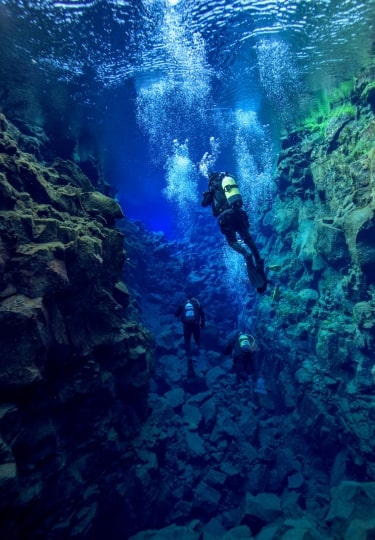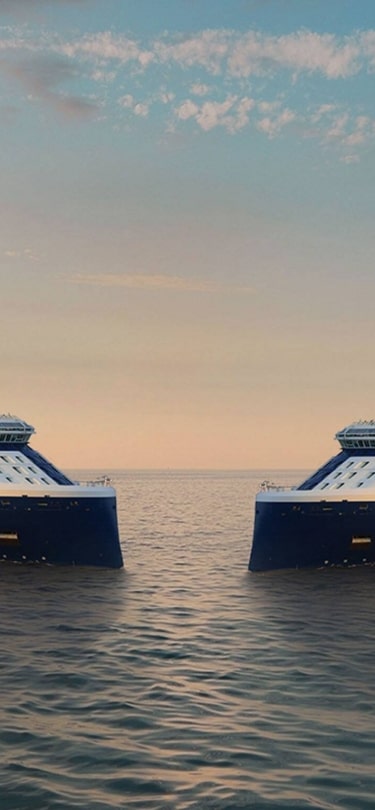Venturing beneath the surface of the sea grants us access to an entirely different world. Scuba diving offers an exciting way to explore rich and diverse waters when traveling. At the sites with the best scuba diving in the world, you’ll discover enchanting marine life, mystical shipwrecks, exciting caves, colorful coral reefs, and incredible underwater landscapes.
Whether you’re a beginner scuba diver or a seasoned professional, there’s a diving spot for every interest and ability level around our amazing planet. From the warm waters of the Caribbean to the glass-clear underwater chasm between two tectonic plates in Iceland, these are some of the best diving spots in the world.
The Great Barrier Reef, Australia
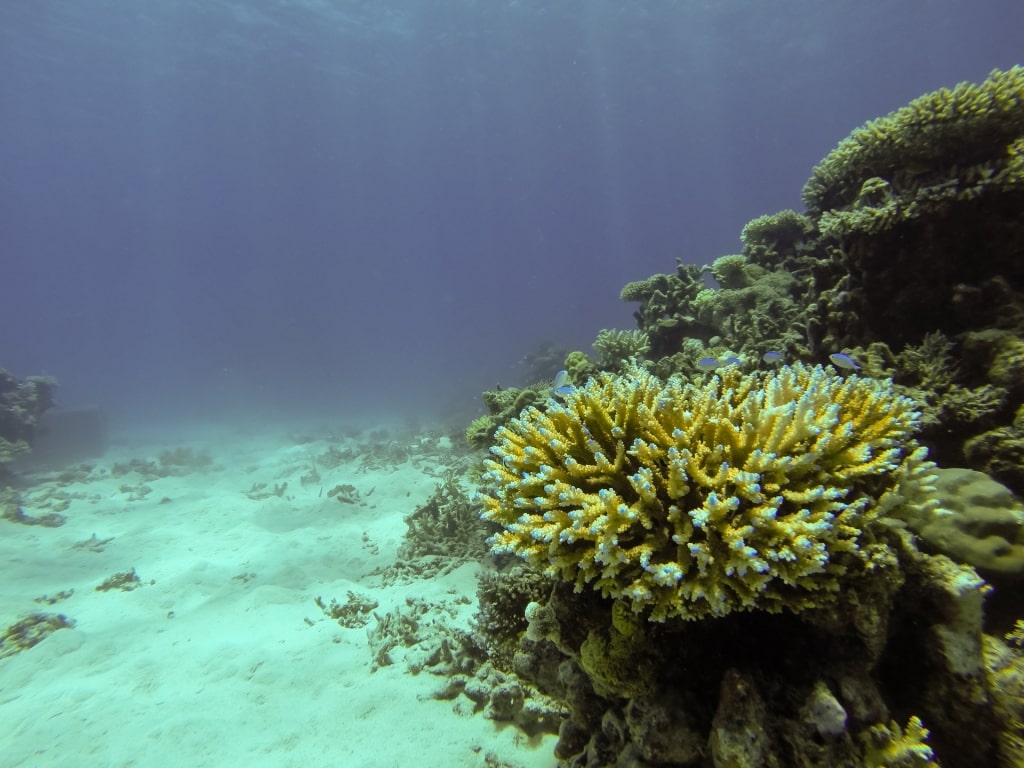
The Great Barrier Reef, Australia
Check off your scuba diving bucket list in Australia’s Great Barrier Reef. The world’s biggest coral reef system in the world is a diver’s haven unlike anywhere else. Underwater photography enthusiasts will enjoy incredible opportunities to capture marine life here.
The Agincourt Reef is a popular destination for divers near North Queensland’s coastal city of Port Douglas; there are more than 40 dive sites here. With so many locations, Agincourt is the perfect choice for any skill level, including novices trying their first open water lesson. Its location on the edge of the continental shelf combined with excellent conditions and visibility makes this reef a prime diving destination in Australia.
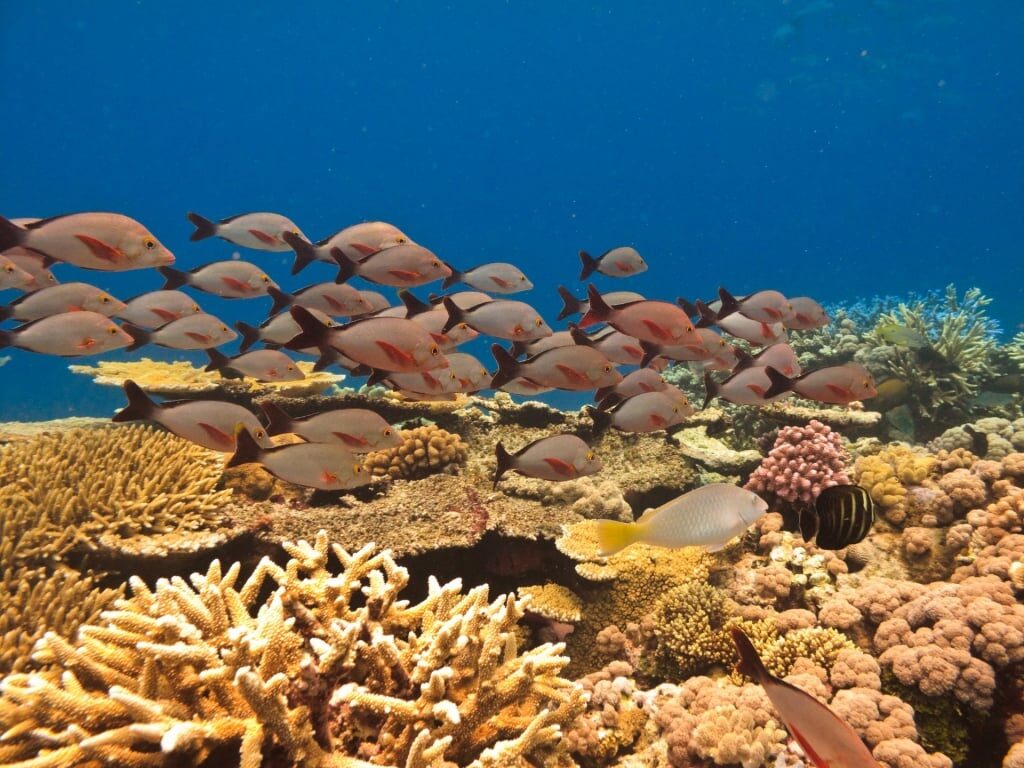
The Great Barrier Reef, Australia
The offshore Ribbon Reef is a favorite and thrilling dive location, particularly Cod Hole, where you could encounter massive groupers. Spot reef sharks, barracudas, stingrays, several species of sea turtle, and even dolphins or whales as you explore dazzling underwater landscapes. When you visit the Great Barrier Reef, you’ll find some of the best scuba diving in the world.
Konanda Wreck, Vila, Vanuatu
Uncover the magical underwater world in the South Pacific islands of Vanuatu where world-renowned diving awaits. The collection of approximately 80 islands offer fantastic scuba diving conditions. Wall, drift, and wreck dives provide the chance to observe sharks, manta rays, and vibrant corals.
The Konanda Wreck is one of the most famous dive locations for its visibility, and abundant sea life that has adapted to living around the remains of this old island freighter. The Konanda was damaged in a typhoon in the 1980s before purposely being sunk for use as an artificial reef. It rests on the sandy ocean floor some 85 feet beneath the surface and has been colonized by all manner of tropical fish.
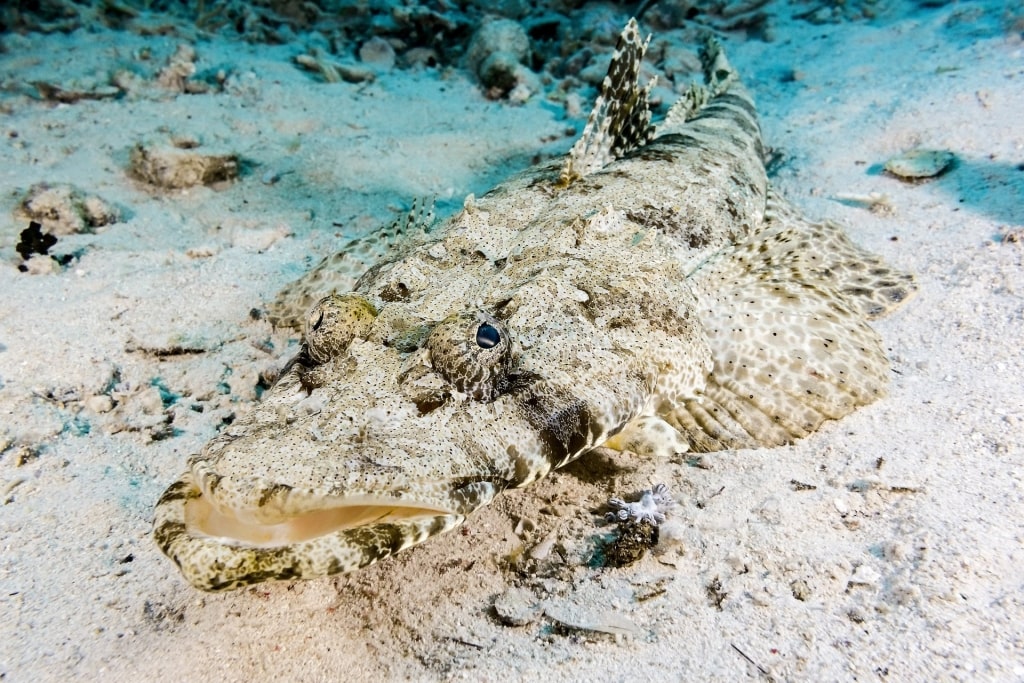
Konanda Wreck in Vila, Vanuatu
The ship is over 140 feet long, with seemingly endless nooks and crannies to explore. Peep at exotic fish through the portholes, or glide through the cabins, where you might see crocodile fish or boxfish. The bridge, the bow, and much of the hull are still intact, offering an underwater world of surprises.
Belize Barrier Reef / Mesoamerican Reef, Belize City, Belize
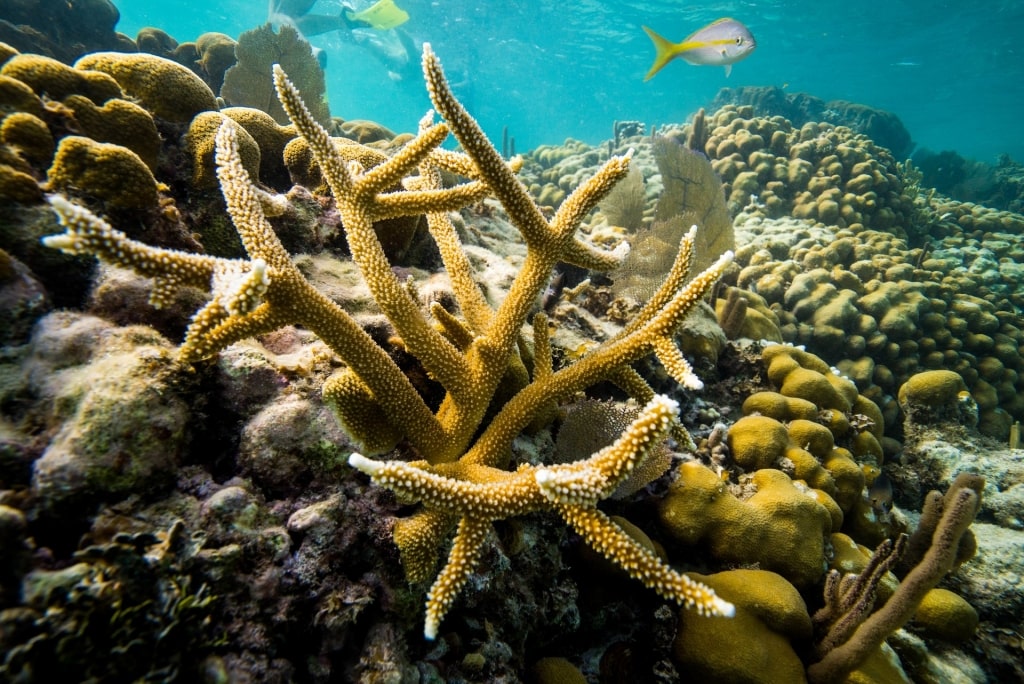
Belize Barrier Reef / Mesoamerican Reef, Belize
The biggest barrier reef in the northern hemisphere, the Belize Barrier Reef is a UNESCO World Heritage Site with several protected areas. Aside from being one of the best places to swim in the world, it’s a dream destination for scuba diving enthusiasts. The reef spans 190 miles and is part of the 560-mile-long Mesoamerican Barrier Reef System.
This diverse ecosystem is composed of cays, atolls, lagoons, mangrove forests, and estuaries, supporting an incredible array of marine species, including turtles, manatees, and over 500 species of tropical fish.
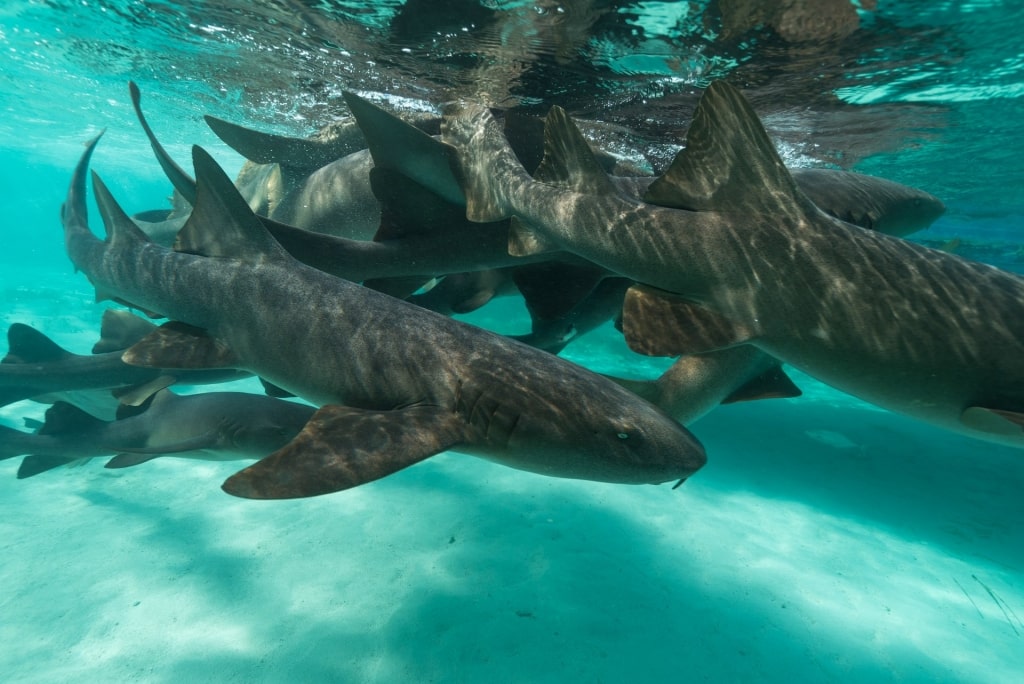
Shark Ray Alley, Belize
Enjoy another famous dive site in Belize with a visit to Shark Ray Alley and Hol Chan where you’ll have a fantastic opportunity to swim among nurse sharks and eagle spotted rays, amongst others.
Bonaire National Marine Park, Kralendijk, Bonaire
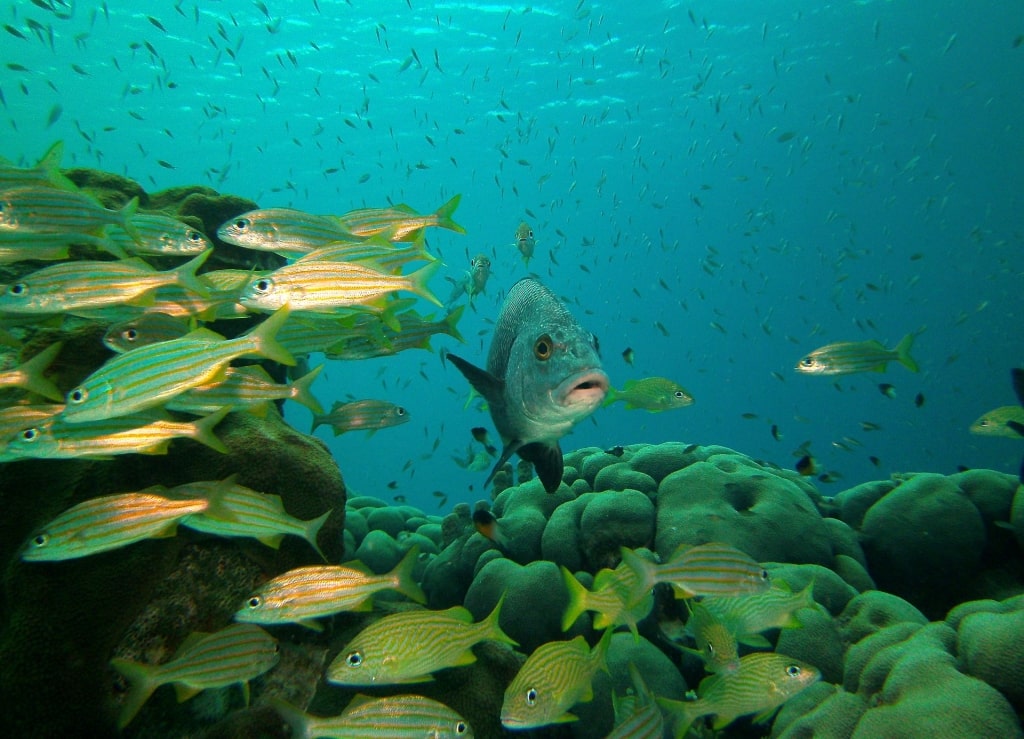
Bonaire National Marine Park, Kralendijk, Bonaire
Bonaire is known as one of the best diving destinations in the world. Divers ranging from novice to advanced will find extraordinary opportunities to enjoy Caribbean scuba diving around the island’s pristine waters. Bonaire has over 80 dive sites, the majority accessible from the shore.
Head below the surface at Bonaire’s top dive location, Bari Reef, just north of Kralendijk. Dive down to 100 feet directly from the shore, where over 300 species of fish dazzle; lizardfish, angelfish, parrotfish, snapper, boxfish, and more.
Watch speedy tarpon zoom by, marvel at graceful turtles, and keep an eye out for reef sharks. The Bonaire National Marine Park is the oldest marine reserve in the world with incredible diving and is suitable for beginners up to advanced divers.
Galapagos Islands (Punta Vicente Roca, Kicker Rock)
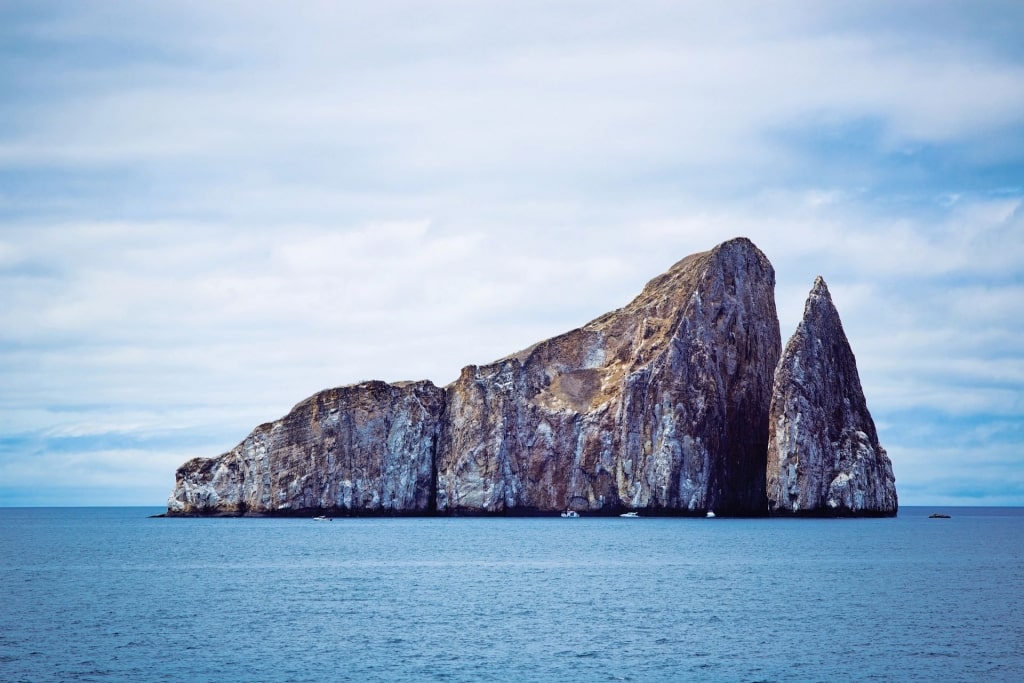
Kicker Rock, Galapagos Islands
The Galapagos Islands are known for their diverse wildlife, both on land and in the sea. With a winning combination of dramatic underwater landscapes and awe-inspiring marine life, this South American destination is a must for scuba divers.
One of the best dive sites in the Galapagos is just off of San Cristobal Island. Kicker Rock is an impressively vertical rock formation, part of an extinct volcano. Erosion has shaped the rock into what appears to be a shoe, the inspiration for its name, although it’s also known as leon dormido, or “sleeping lion”.
The formation soars 500 feet into the air, and below the surface, white-tipped reef sharks and hammerhead sharks circle in the crystal-clear water. A channel between the rocks is the perfect place to find these shark species, as well as rays, sea lions, turtles, and diverse schools of reef fish.
Silfra Fissure, Thingvellir National Park, Reykjavik, Iceland

Silfra Fissure in Thingvellir National Park, Iceland
Head to the far north of Europe, where you can experience one of the most unique and thrilling dive locations in the world, the Silfra Fissure, less than an hour from Iceland’s capital city, Reykjavik.
You’ll have the opportunity to plunge between the North American and Eurasian tectonic plates in pristine glacial meltwater, regarded as the clearest in the world, with visibility of more than 300 feet. Aside from being one of the most beautiful places in Iceland, this is the only place in the entire world to offer this particular diving experience.
Admire the vibrant colors of Iceland’s underwater world as you venture through the four landscapes of the Silfra Fissure; the lagoon, Silfra Hall, Silfra Cathedral, and the most well-known spot, the cavernous Silfra Crack.
Gaze at incredible rock formations of volcanic basalt rock, vividly colored marine algae, and a spectrum of blue-green hues as you glide between the tectonic plates. The Silfra Fissure is considered one of the best diving spots in the world.
Cozumel National Marine Park, Cozumel, Mexico
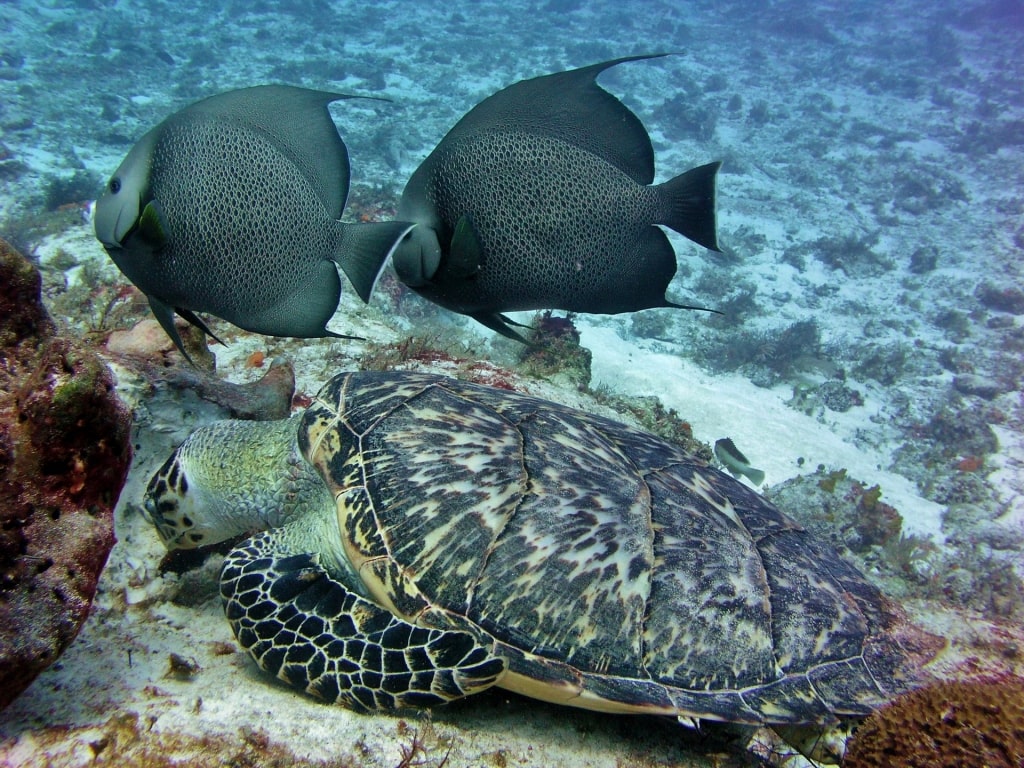
Cozumel National Marine Park in Cozumel, Mexico
Discover some 30,000 acres of protected natural coastline in Mexico, home to over 250 species of fish and 105 different types of dazzling coral. Cozumel National Marine Park is located along the southern edge of the island and is a popular destination for divers.
Whether you’re a beginner or an experienced diver, descend into the warm, turquoise waters of what is considered the “drift diving capital of the world”. This means that rather than swimming against a current, you let it carry you effortlessly along, making this the most relaxing way to gaze at the underwater world during your time in Cozumel.
Clear seas with impeccable visibility create perfect conditions for viewing colorful coral gardens, barracuda, the endemic toadfish, lush sponges, eagle rays, king crab, angelfish, and tangs. Explore Paradise Reef, a preferred dive spot for beginners, with brilliantly colored sponges and gorgonians, or soft corals. It’s also an exciting location for those interested in night diving, when you’ll be able to observe octopus, king crabs, and lobsters.
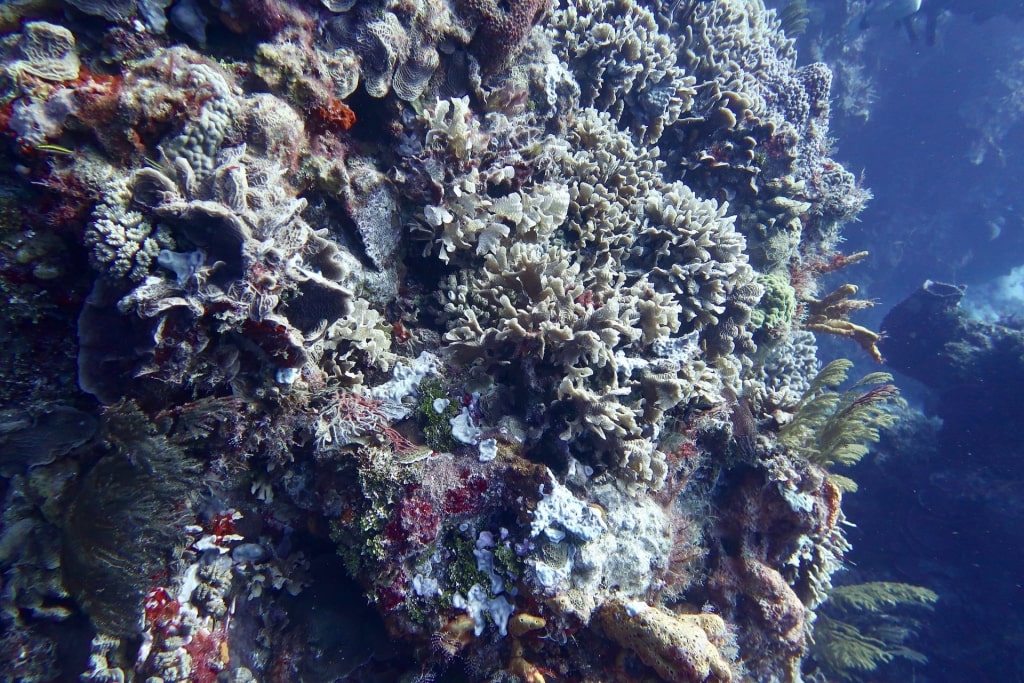
Santa Rosa Wall, Cozumel
Another fantastic dive location within the marine park is the Santa Rosa Wall, ideal for intermediate divers. Dive down to 80 feet where you’ll unearth mystical tunnels where horse-eyed jacks, eagle rays, groupers, and lobsters hide, while turtles glide through the blue depths.
Read: Best Places for Snorkeling in Cozumel
RMS Rhone, Tortola, BVI
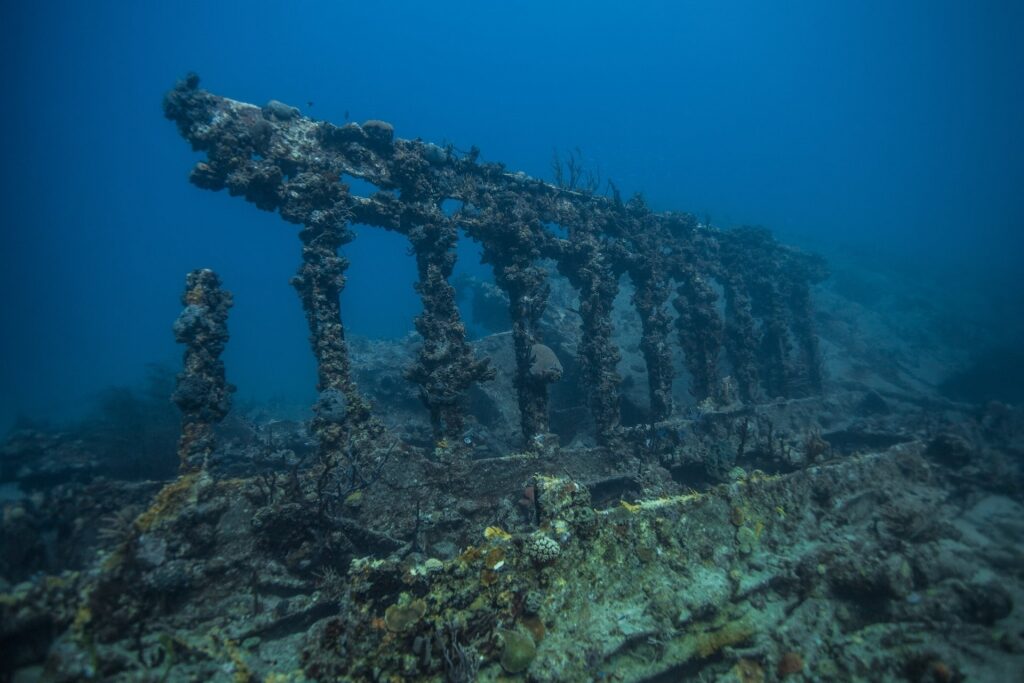
RMS Rhone in Tortola, BVI
Explore the deep waters around the island of Tortola, a gem of the British Virgin Islands. One of the most celebrated dive spots here is the RMS Rhone, a shipwreck within the marine park, southeast of the island.
The Rhone sank in 1867. Its remnants stretch over 300 feet and are still relatively intact, making it a treat to dive. As you explore the wreck site, you’ll discover the sea creatures that have colonized the old ship, which lies between Dead Chest Island and Salt Island.
Swim by stunning coral gardens on the lookout for pufferfish, octopus, green moray eels, and damselfish. You’ll see the ship’s deck, propeller, cannon, and steam engine as well as artifacts such as silverware and tools. This exciting dive actually takes two dives to explore thoroughly as the ship had split in half when sinking.
Butler Bay Wrecks, St. Croix
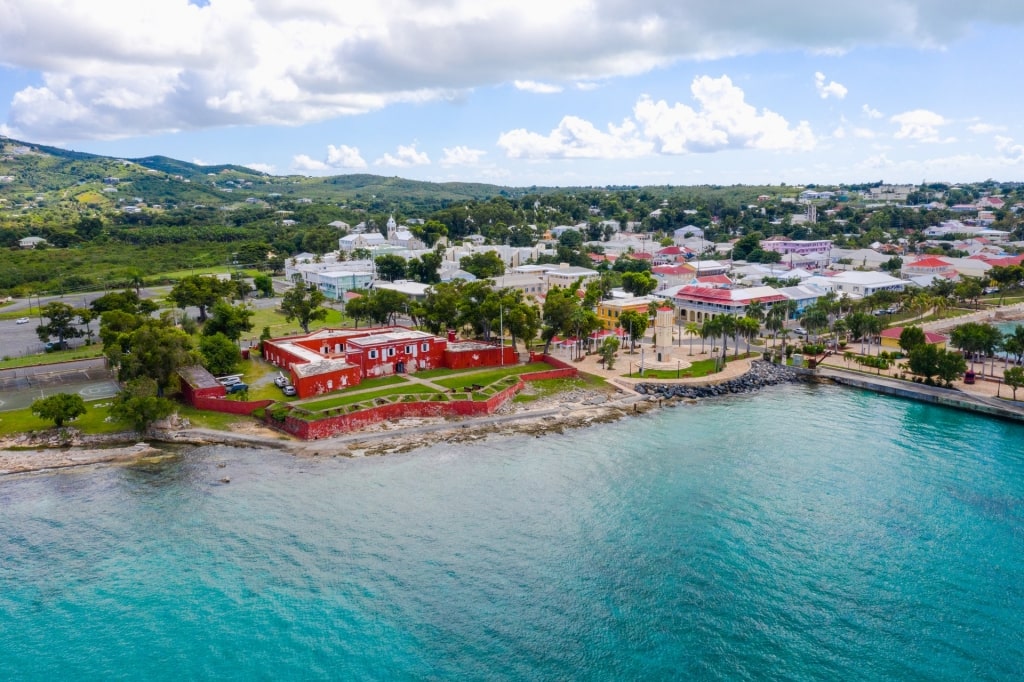
Butler Bay, St. Croix
Dive into the diverse and inviting underwater realm of St. Croix in the US Virgin Islands. Hailed as one of the most amazing places to experience scuba diving in the Caribbean, it’s also one of the singular places where it’s possible to explore a wall, wreck, pier, and reef in one day.
One of the most popular dive sites is The Butler Bay Wrecks, a trio of wrecks ideal for intermediate to advanced divers. The ships rest at various depths, the furthest being 80 feet below the surface of the island’s north shore.
The wrecks of Suffolk Maid, Northwind, and Virgin Islander, a 300-foot long oil barge, in combination with the Aegir underwater habitat, provide an underwater playground. Spot vibrant tropical fish such as pufferfish, blue tang, queenfish, and angelfish among coral and sponges that have taken up residence throughout the remnants.
St. Croix has up to 40 types of coral, creating a beautiful landscape beneath the surface. With visibility typically up to 100 feet, this dive is one of the unmissable things to do in St. Croix.
Escambrón Marine Park, San Juan, Puerto Rico
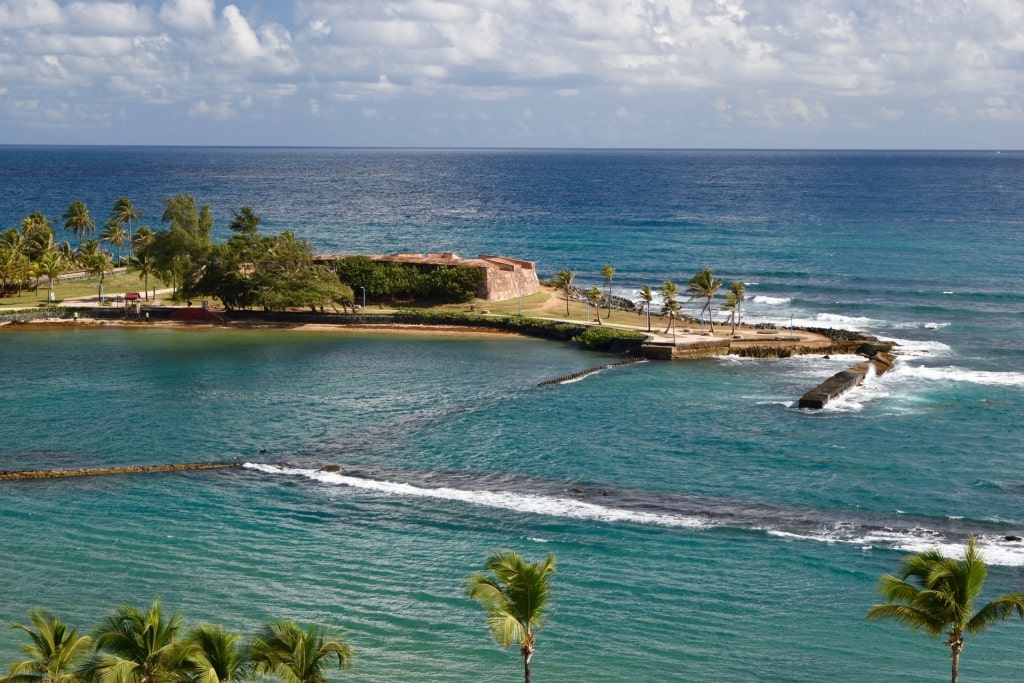
Escambrón Marine Park in San Juan, Puerto Rico
Discover the magical underwater world of Escambrón Marine Park, located near San Juan, Puerto Rico. The reefs within the protected park are home to a stunning array of marine life, with coral colonizing several man-made structures.
What’s more, this shallow dive with great visibility makes this a prime spot for divers of all skill levels and allows for longer dive times.
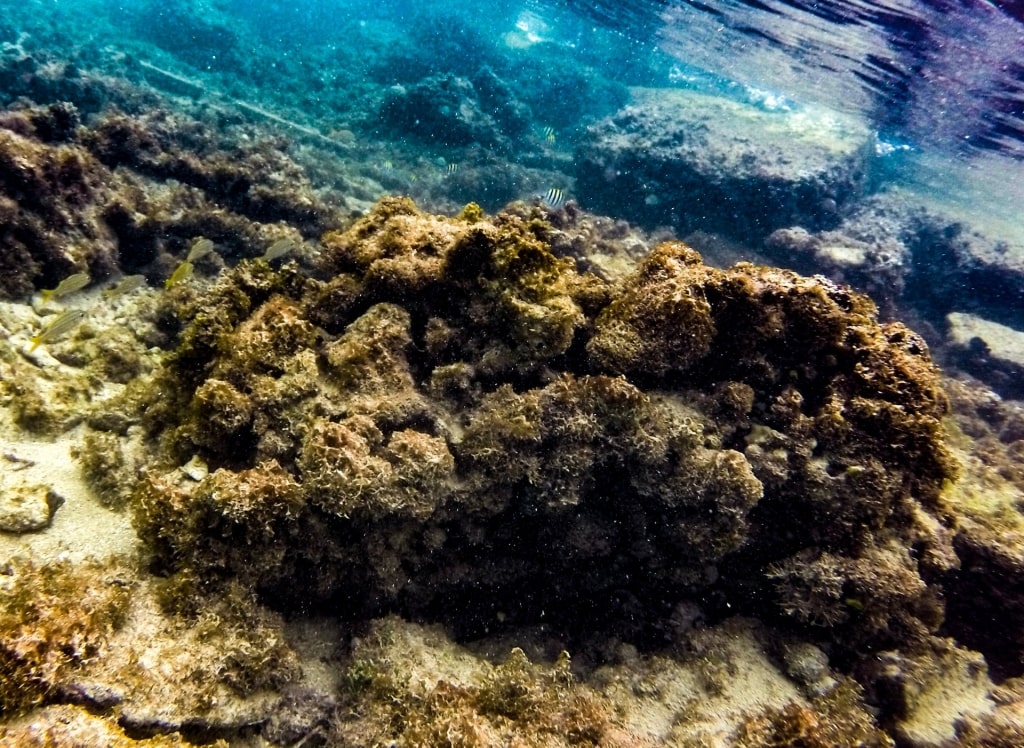
Escambrón Marine Park in San Juan, Puerto Rico
Weave through the ruins of “Atlantis,” where a wide array of tropical fish dart around underwater statues and Roman-inspired columns.Other A-frame structures also provide an ideal habitat for sea creatures such as yellowtail snappers, blue tangs, sergeant fish, porkfish, and damselfish.
If you’re interested in viewing sea turtles, meander over to the Seaweed Forest, a sandy area where swaying seagrass grows, a favorite snack for turtles. Another notable area is the Labyrinth Reef, known for its dramatic rock formations, while intriguing species such as porcupine fish can be spotted around the Fish Protection Wall.
Cayman Salvager, Key West, USA
Florida’s Key West is one of the best diving spots in the U.S. outside Key Largo. The good news is that the extraordinary Florida Keys Wreck Trail connects both.
Off Key West, the most accessible dive site for those with Advanced Open Water certification is the wreck of the Cayman Salvager. This ship was used for cable laying and drug smuggling, and had many other adventures before sinking here during a storm in 1985.
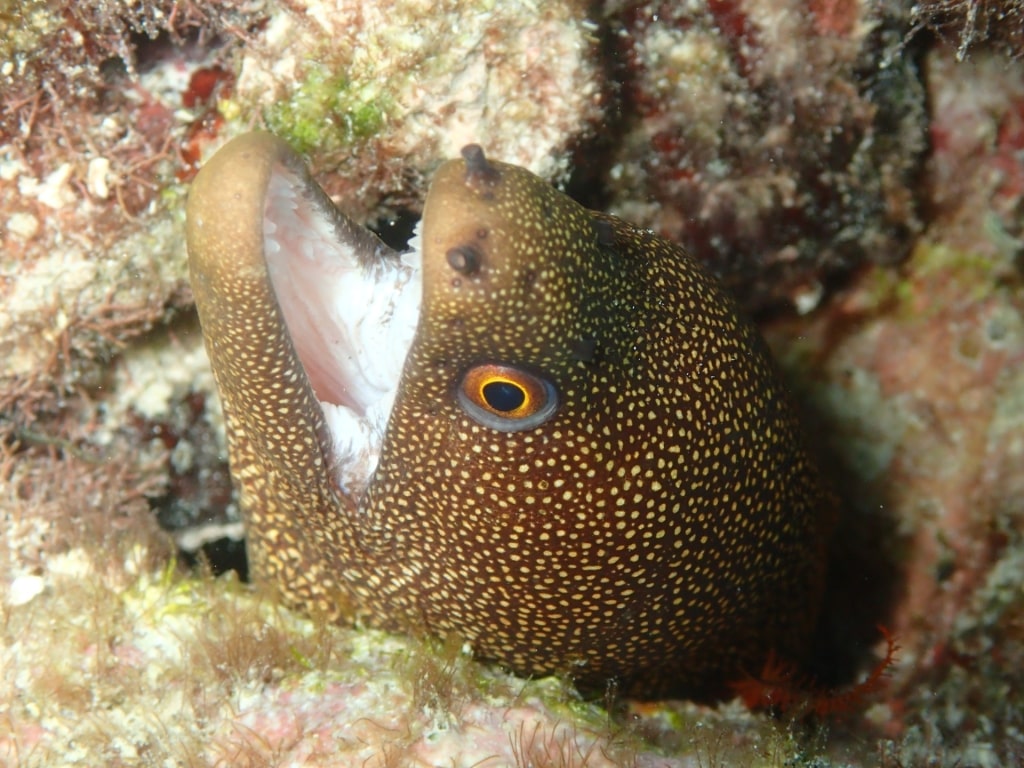
Moray eel
Standing upright at 90 feet deep, the ship throngs with marine life, including resident goliath groupers, moray eels, and an octopus. With great visibility, weak currents, and its picturesque profile, the wreck is ideal for underwater photographers.
Closer to the ship, you’ll spot details such as a large cable spool, three bicycles, and even a payphone. Actually going inside, however, is not recommended without up-to-date advice from an experienced dive master.
Cirkewwa, Malta

Cirkewwa, Malta
Its crystal clear waters make Malta one of the best diving spots in the world. Water temperatures average 67°F throughout the year, hitting 80ºF in late summer.
The best dive site on this beautiful island is at Cirkewwa on the northwest coast. There is something for everyone here, from a training pool to two deliberately sunken boats.
Swim-through tunnels and caves and two delightful natural arches are other attractions. Diving is from the shore, with some of Malta’s best beaches, cafés, and many other facilities—including free parking for divers—nearby.
From Cirkewwa you can also take the ferry to the small island of Gozo, where you’ll find the famous Blue Hole. Surrounded by coral gardens, it has an amazing underwater arch leading to the open sea.
Dubrovnik, Croatia
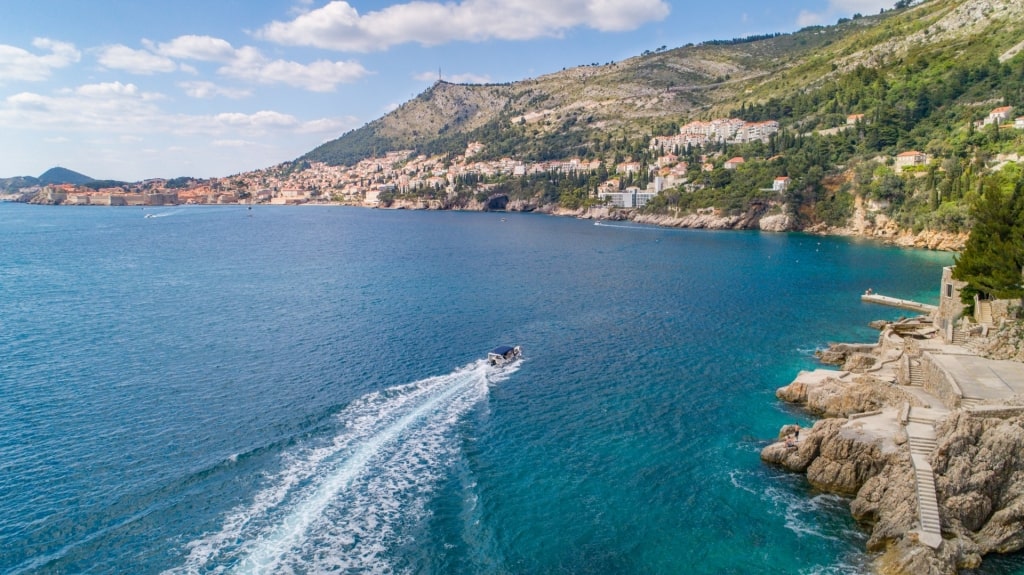
Dubrovnik, Croatia
There are not many cities in the world where you can enjoy dozens of different dives nearby. The ancient city of Dubrovnik boasts at least 50 sites highlighting the appeal of the clear blue waters of the Adriatic.
These dives range from a sheer rock wall on Lokrum Island to the 1943 wreck of the SS Taranto, an Italian navy ship. Lokrum is also famous for the “Dead Sea”, a hidden lake reached through swimming along a semi-submerged tunnel.
One highlight is Mala Africa or “Little Africa”, which is known for its abundant marine life. The reef here plunges from 30 to more than 100 feet and you’ll see scatterings of broken clay amphora as well as schools of fish.
Around these dive sites, you can expect to see conger and moray eels, seahorses, octopus, and many more species. Summer water temperatures hit highs around 77°F, perfect for diving.
Menjangan Island, Indonesia
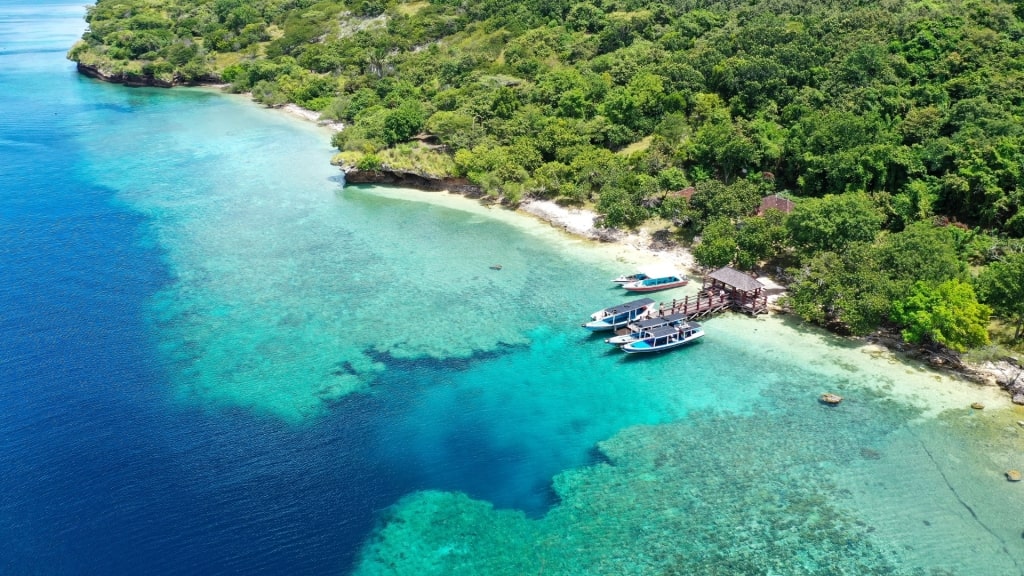
Menjangan Island, Indonesia
Menjangan Island is just off the northwest coast of Bali, Indonesia. Part of West Bali National Park, the island is known for its superb wall diving and beautiful coral reefs.
Its reef encircles the island, dropping away to depths up to 200 feet. You’ll see strange rock formations, sponges, and soft corals.
Caves and crevices attract groupers, moray eels, snappers, and batfish. You should also spot shoals of fish such as jackfish and angelfish, as well as sea turtles and even tuna.
Another attraction is the wreck of a wooden vessel, named for the two anchors that remain. Diving on the “Anchor” takes you from 20ft down to depths up to 150ft for experienced divers.
Visibility here is excellent and currents are calm—attested to by the delicate gorgonians. It’s just off the Eel Gardens, another dive site where you might see reef sharks over dazzling white sand.
Stingray City, Grand Cayman
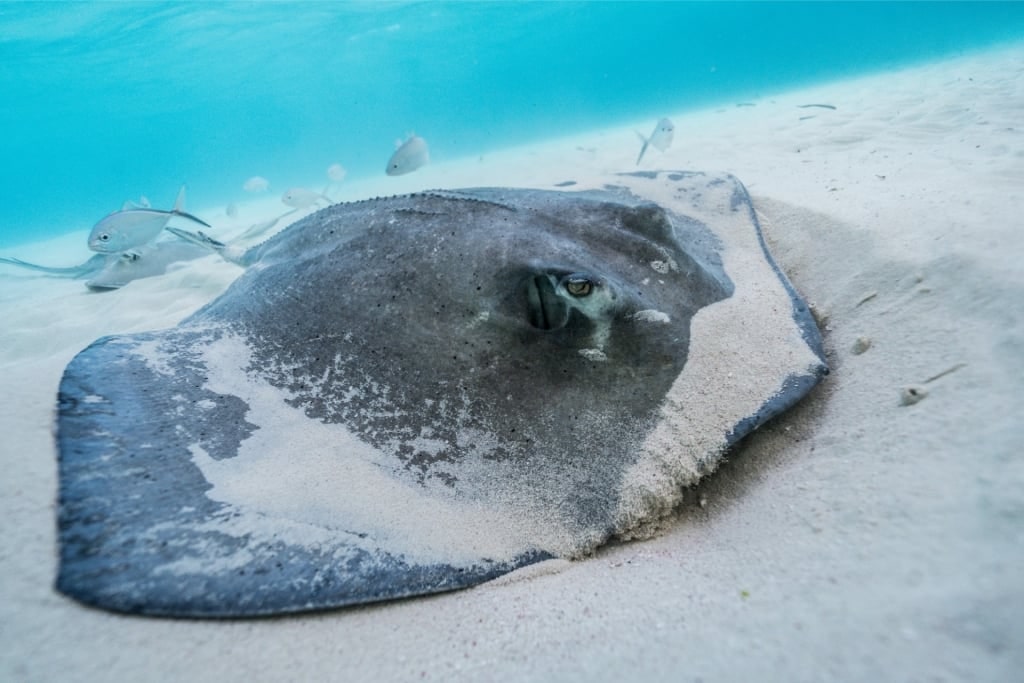
Stingray City, Grand Cayman
Grand Cayman is a diver’s delight, with warm water, outstanding visibility, and sites suitable for all abilities. One beginner-friendly site on the island that will make anyone fall in love with diving is Stingray City.
Among the best dive and snorkel sites in the world, Stingray City is a 30-minute boat ride from George Town. It’s made up of a shallow sandbar, suitable for snorkelers, and a deeper dive site.
Divers stand or kneel in a group on the bottom at around 12 to 15 feet while being circled by southern stingrays. The rays have been accustomed to people through decades of being fed, originally by fishermen gutting their catch.
It’s a magical experience to encounter these graceful creatures so closely. A safety briefing ensures the rays are treated respectfully and helps keep the dive risk-free.
Antilla Wreck, Aruba
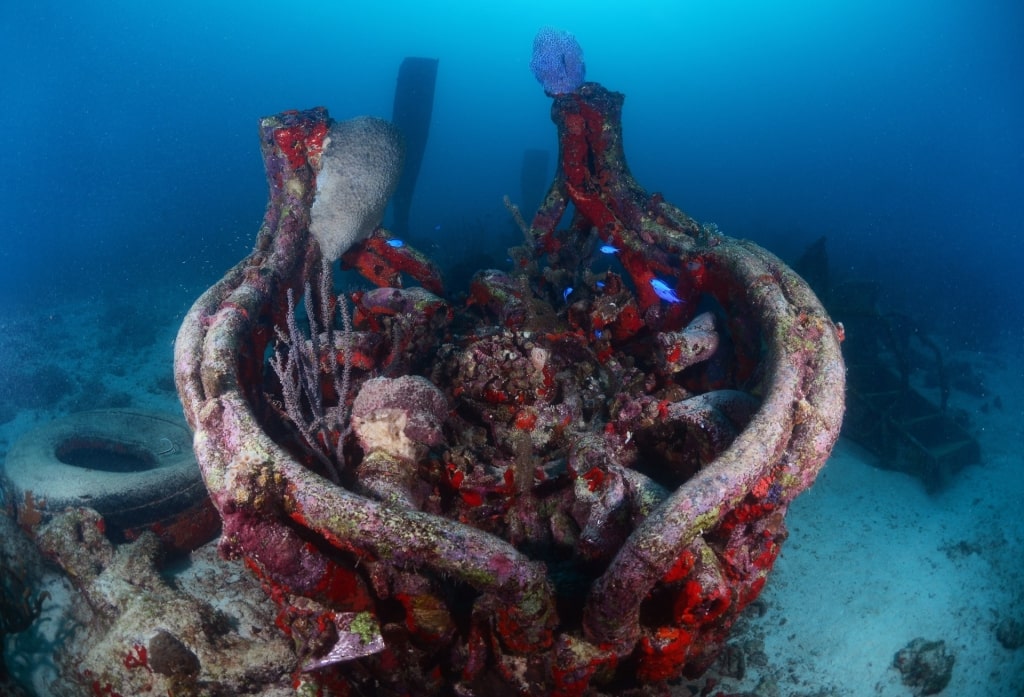
Antilla Wreck, Aruba
The SS Antilla is a German cargo ship from the WWII era, scuttled by its crew in 1940. At 400 feet long, broken into several sections, it’s one of the largest diveable wrecks in the Caribbean.
Now heavily encrusted with corals and sponges, the wreck is home to large numbers of schooling tropical fish. It’s also common to see lobsters, turtles, and moray eels, with occasional barracuda or groupers.
The ship lies in relatively shallow water at 30 to 60 feet deep, off the northwest coast of Aruba. You can look into the bridge and cargo holds, or enjoy several swim-throughs.
However, storms—which broke up the ship—continue to degrade it. Be wary of entering the wreck unless with an experienced dive master.
Champagne Reef, Dominica
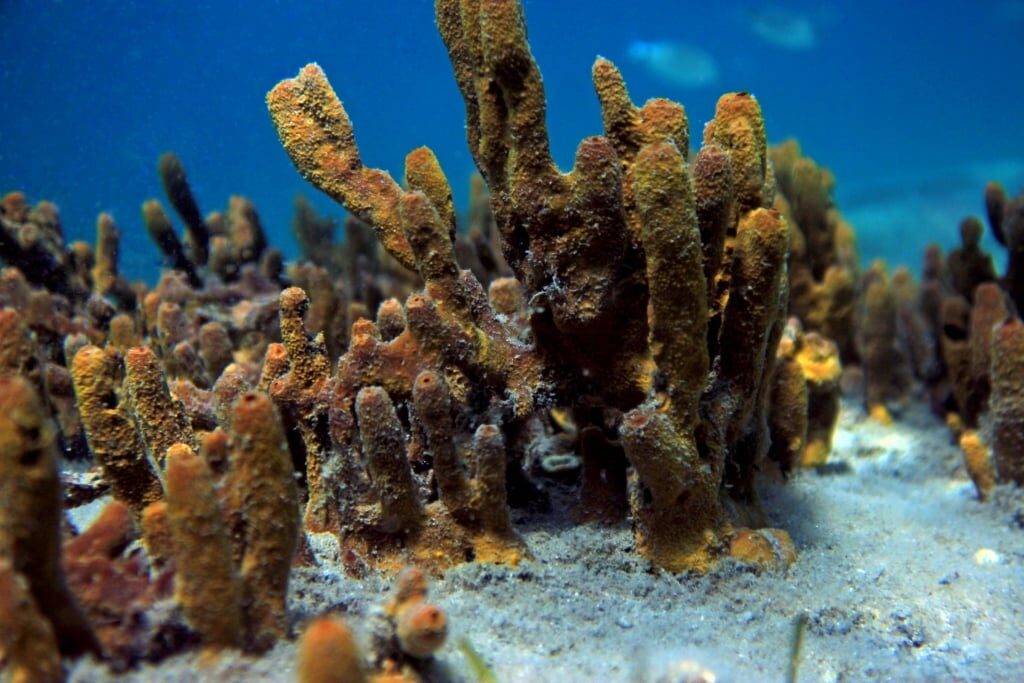
Champagne Reef, Dominica
Champagne Reef takes its name from the bubbling water that rises from the ocean floor here. The bubbles come from volcanic geothermal springs that also encourage a rich variety of beautiful sponges.
Swimming amid bubbles and through areas of warm water makes this one of the best diving spots in the world. You enter over black sand which contrasts with the golden “champagne” area.
This southwest part of Dominica is protected within the Soufriere Scotts Head Marine Reserve. While snorkelers often throng the shallower parts, divers can go further afield to explore the rest of the reef.
You’ll find steep cliffs and rock towers, with many colorful crinoids, better known as sea lilies. Fish species include damsels, sergeant majors, and trigger fish—with octopus, rays, and hawksbill turtles also in the area.
Creole Rock, St. Maarten
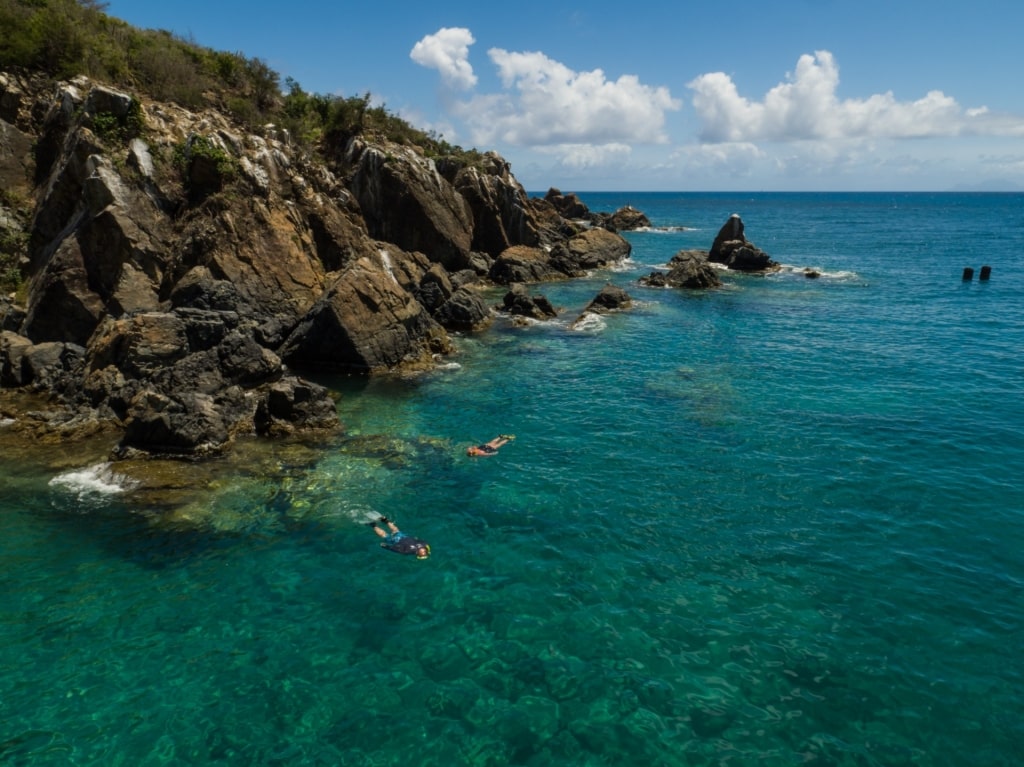
Creole Rock, St. Maarten
Creole Rock is a ten-minute boat ride from Grand Case on the northern coast of French St. Martin. Suitable for both beginners and intermediate divers, it takes you to depths of 20 to 50 feet.
One of the best spots for scuba diving in St. Maarten, it’s notable for its large schools of tropical fish and regular sightings of sea turtles. You should also see spotted eagle rays and southern stingrays, with an occasional nurse shark.
Snorkelers can also enjoy the rocks, searching for reef fish such as parrotfish and angelfish. Meanwhile, divers will want to explore small caves and swim-throughs and some larger coral formations.
Creole Rock is small enough to swim around, although its protected status means you can’t land on it. Boats are not allowed within 100 feet either, so make sure you stay in touch with your dive buddy.
Pigeon Island Marine Reserve, St. Lucia
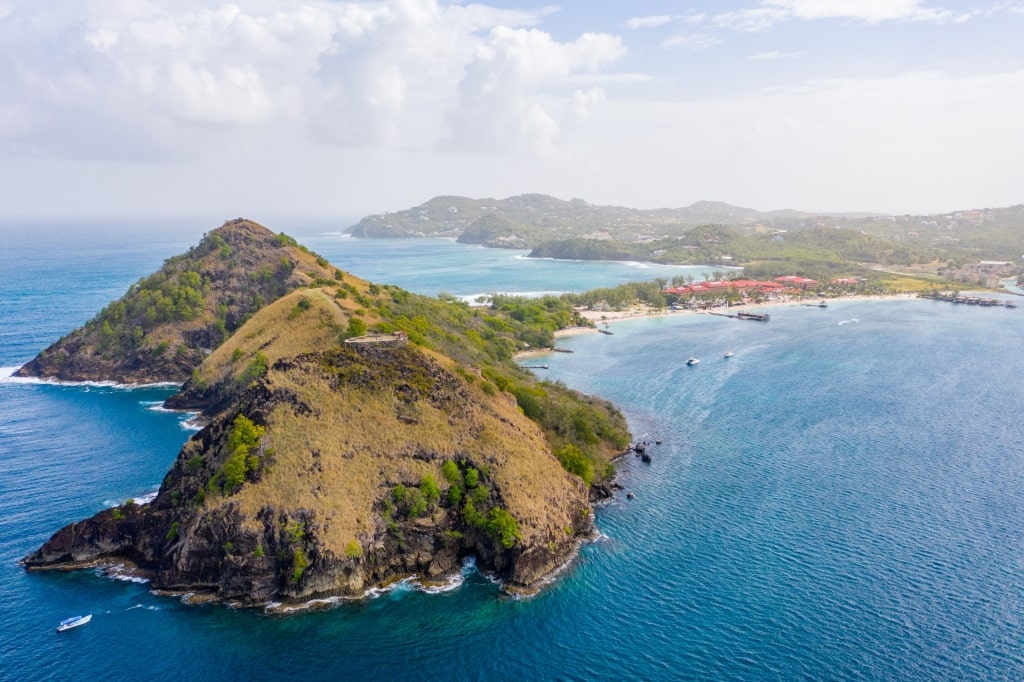
Pigeon Island Marine Reserve, St. Lucia
Pigeon Island—now a peninsula—is best dived on a quick boat ride from nearby Rodney Bay Marina in St. Lucia. Its sheltered southern side holds a gently rolling coral reef, with both hard and soft corals.
You’ll see your first coral at about 15 feet and the reef will take you down to around 60 feet. At this point, the seabed starts to throw up large, picturesque rock boulders.
The reef thrives with species such as snappers, jacks, and spotted eagle rays. You might even see a cruising barracuda or green moray eel.
If the weather is calm, you can extend the dive at “The Rock”, a small outcrop further southwest. This is a short drift dive amid a varied bottom rich with coral and fish life.
Cades Reef, Antigua
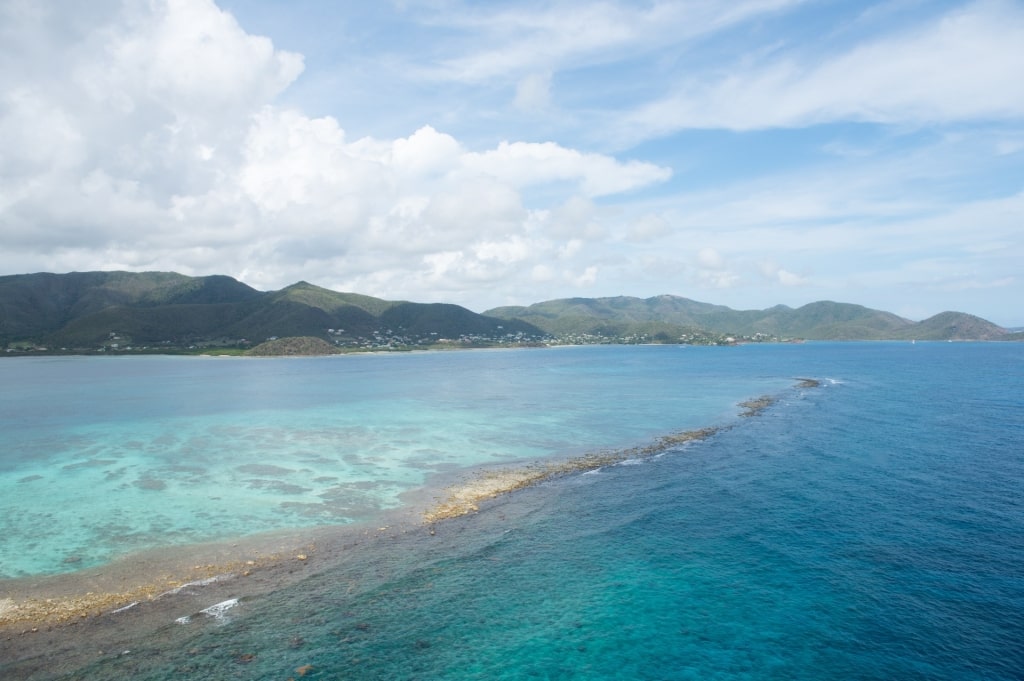
Cades Reef, Antigua
Lying off the southwest coast of Antigua, Cades Reef is about 20 minutes from Jolly Harbour. The reef stretches for almost two miles at depths averaging 20 to 40 feet.
The rich variety of underwater life here is protected within the Cades Bay Marine Reserve. You’ll see plenty of Caribbean reef fish, with common sightings of barracuda, sea turtles, moray eels, and reef sharks.
A highlight for underwater photographers is the wreck of the Andes, a three-masted merchant ship that sank in 1905. Sitting in only 30 feet of water, it is well lit by surface light, leading to some excellent photo opportunities.
The warm, clear water is ideal for divers and snorkelers to enjoy extended visits. Strong currents can be a problem on the outer fringes of the reef, which has a steep drop-off, so do stay alert to your position.
The Bimini Road, Bahamas
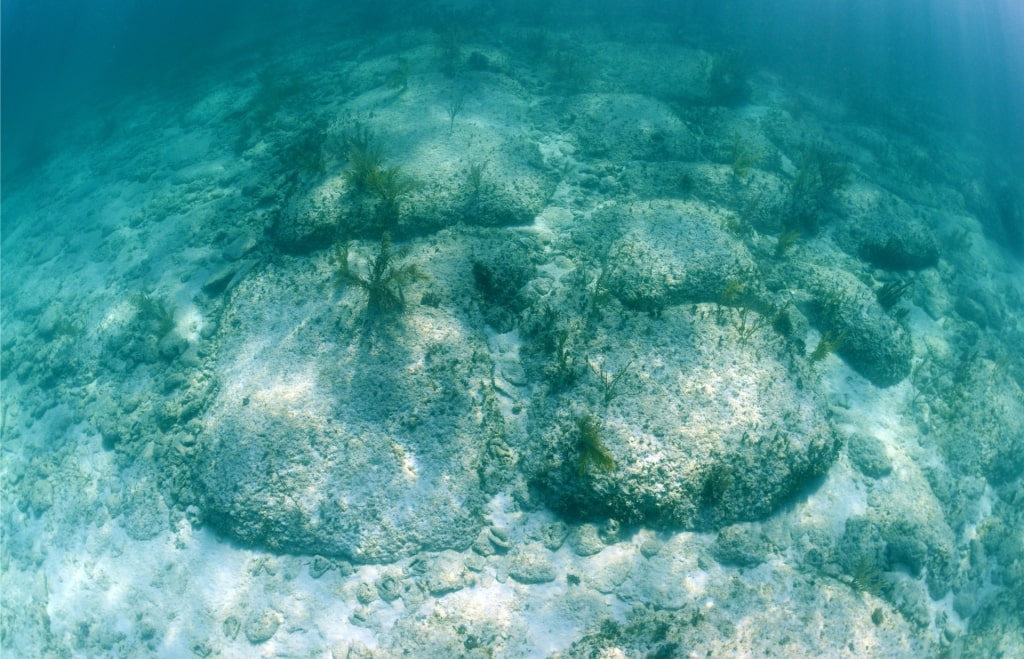
The Bimini Road, Bahamas
This dive site in the Bahamas—also known as Bimini Wall—is a relatively shallow 15 to 25 feet deep. It’s an underwater rock formation that has been claimed to be part of the Lost Continent of Atlantis.
You will see a flat, half-mile expanse of massive interlocked limestone blocks that do seem road-like in appearance. It’s hard not to see the whole as man-made, but geologists consider it to be a natural formation.
Many believers do claim to feel a special natural energy on this spot. Hopefully, you will at least connect to the pods of playful spotted dolphins that frequent the area.
The site is otherwise undramatic, with some corals, nudibranchs, a few lobsters, and sea fans waving in the current. The shallow depth and normally clear water do offer excellent conditions for underwater photography.
Christ of the Abyss, San Fruttuoso, Italy
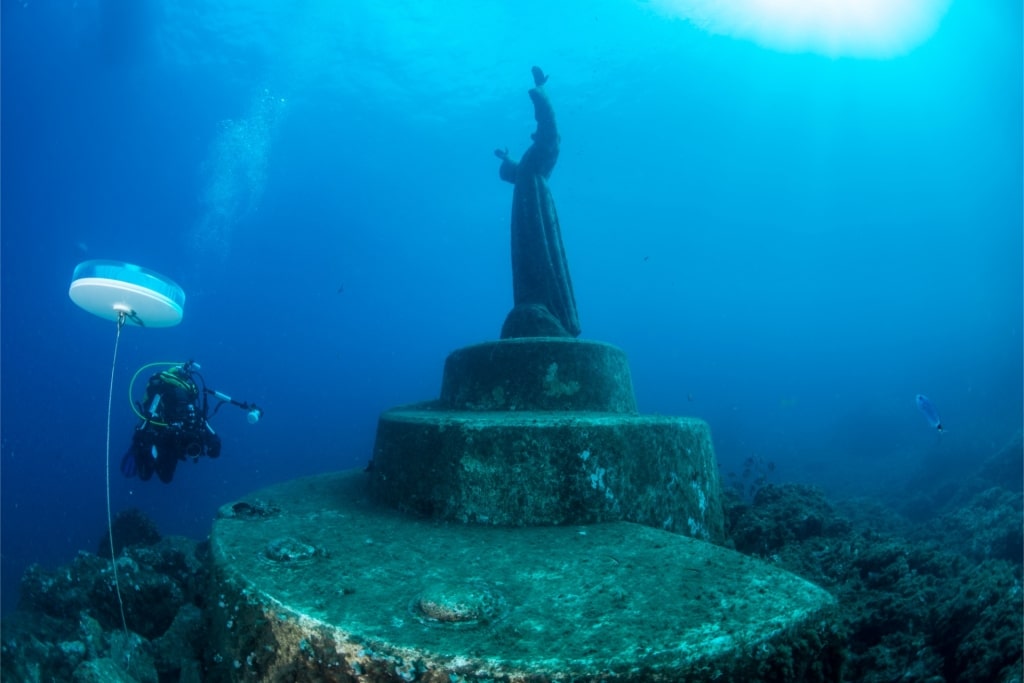
Christ of the Abyss in San Fruttuoso, Italy
The Christ of the Abyss is a bronze statue sitting at a depth of 55 feet in the Mediterranean Sea. One of the world’s best underwater statues, you’ll find it in the pretty bay of San Fruttuoso, 45 minutes from Portofino in Italy.
The 8.5-foot tall underwater statue, standing on a concrete plinth, was placed here in 1954 to commemorate pioneer diver Dario Gonzatti. Sculptor Guido Galletti dedicated it to all those divers lost at sea, using metal artifacts donated from around the world.
In the decades since, the figure has become softened by the growth of coral and other marine life. Its outstretched arms add to its ethereal appearance as it emerges from the depths.
Strong currents make this a site for intermediate divers, but it can become crowded in peak summer season. Glass bottom boat tours allow even snorkelers or non-divers a glimpse of this haunting sight.
Cies Islands, Spain
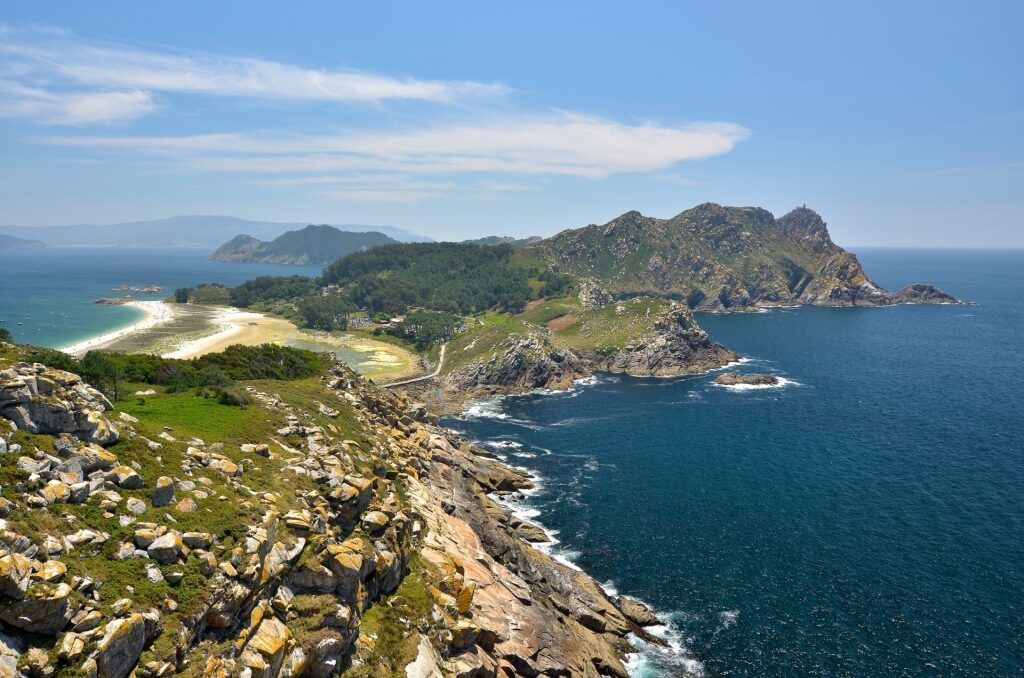
Cies Islands, Spain
Standing off the port of Vigo in northern Spain, the Cies Islands are known for some of the world’s best beaches. Their tropical appearance belies the cold Atlantic waters but a good wetsuit opens up a world of wonder.
Instead of colorful reef fish, you’ll see cold water species such as European lobster, spider crab, and octopus. Rocks are covered in barnacles, mussels, and sea urchins, with forests of anemones.
Notable features include deep sea caves, a coral wall, and the presence of whales, dolphins, or even basking sharks. Entry is by walking off the remarkable white sand beaches and visibility is typically up to 60 feet.
The islands are within the Galicia National Park and the number of daily visitors is firmly controlled. Plan well ahead with a dive company to make sure you can have a permit to visit.
Oahu, Hawaii

Oahu, Hawaii
Hawaii is so well known for surfing that some of the best diving in the world is often overlooked. The calmer summer months are great for exploring places close to Honolulu such as the Pupukea Marine Sanctuary.
A notable spot for divers for all abilities and also accessible to snorkelers is Turtle Canyon just off Waikiki. It’s named for the number of green sea turtles who come here to have algae cleaned off their shells by symbiotic fish.
These fish include damselfish, tangs, angelfish, and wrasse. Visibility is excellent and divers should see octopus, eel, and plenty of other reef fish.
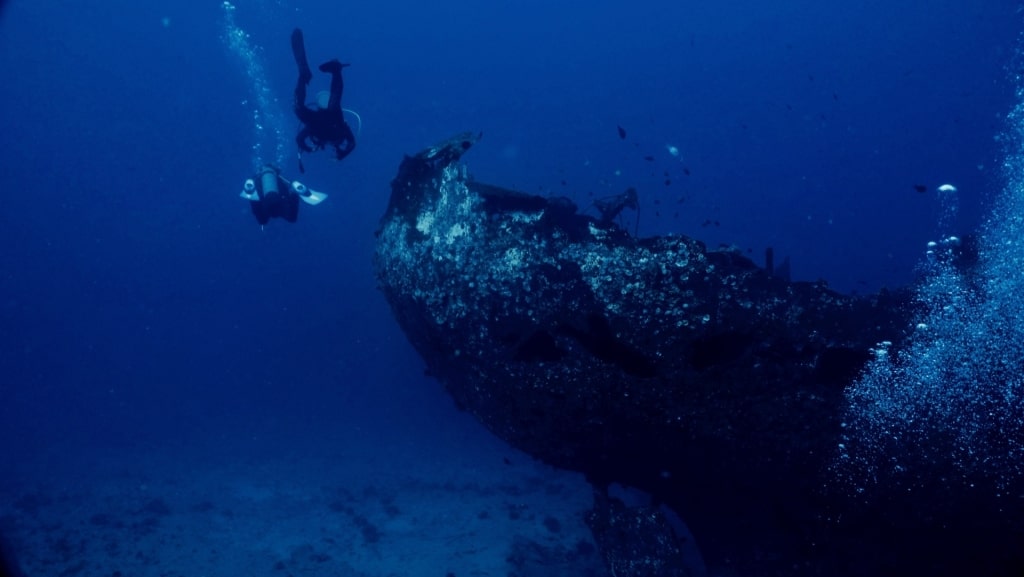
San Pedro wreck, Hawaii
Nearby are the twin wrecks of the YO-257 and San Pedro, two ships deliberately sunk to make an artificial reef. Home to turtles, rays, and whitetip reef sharks, these are only suitable for advanced divers.
Read: Best Spots for Scuba Diving in the Caribbean
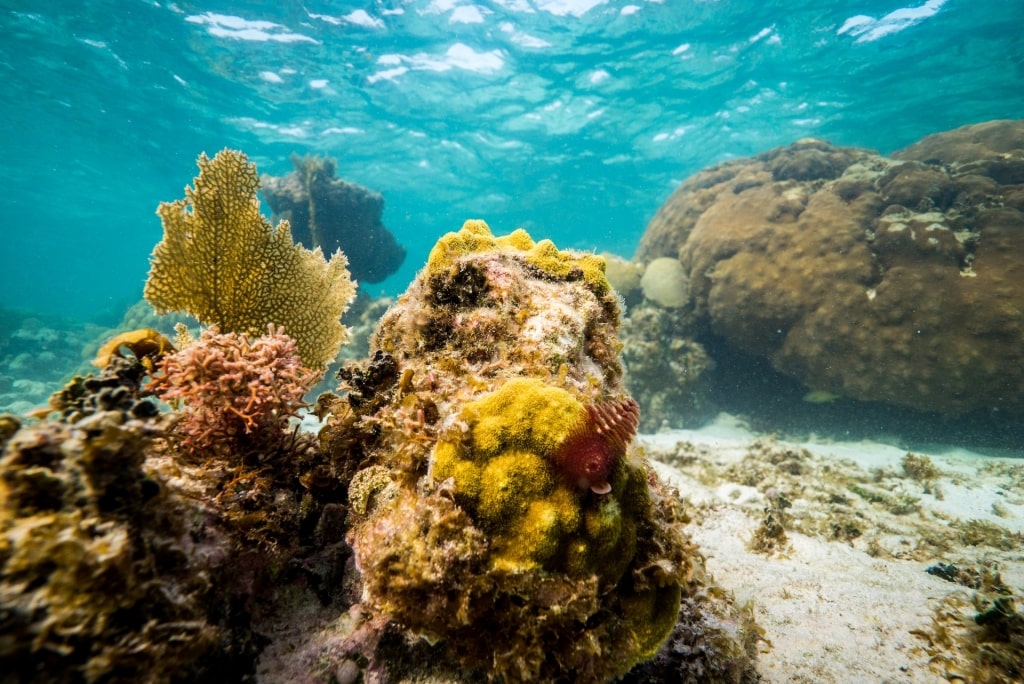
Belize Barrier Reef / Mesoamerican Reef in Belize City, Belize
The sport of scuba diving offers endless opportunities to discover the captivating landscape beneath the ocean surface. A cruise is a fantastic way to experience some of the best diving spots in the world, whether you’re intrigued by wrecks, reefs, or caves. Browse itineraries on our website and book your scuba diving adventure today.
